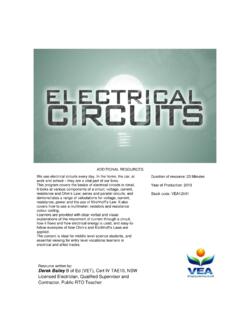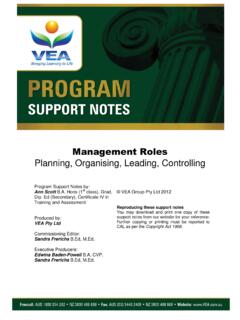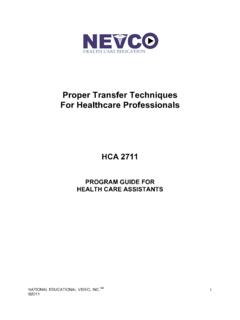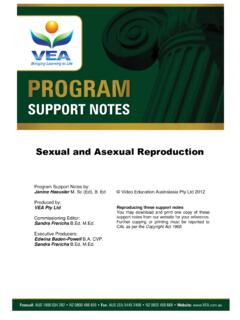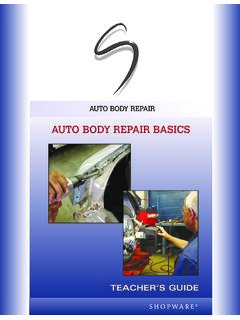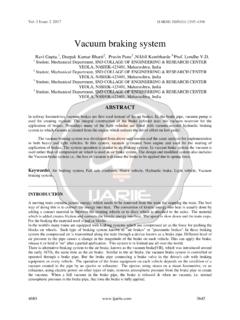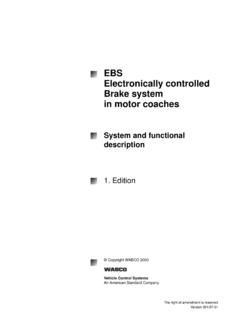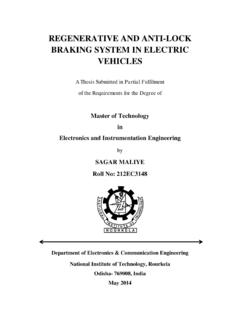Transcription of BRAKING SYSTEM REPAIR - Infobase
1 SHOPWARE TEACHER S GUIDEBRAKING SYSTEM REPAIRAUTO BODY REPAIRINTRODUCTIONThis Teacher s Guide provides information to help you get the most out of BRAKING contents in this guide will enable you to prepare your students before using theprogram and present follow-up activities to reinforce the program s key learning SYSTEM REPAIR describes testing and diagnosing necessary repairs to BRAKING sys-tems. After viewing this video and completing some of the learning activities included in thisguide, students will be better prepared to bleed, flush, and pressure-test a brake hydraulicsystem; remove a caliper assembly; and check parking brake SYSTEM operation.
2 Use theBraking SYSTEM Repairvideo and accompanying activities provided in this guide to teachstudents basic BRAKING SYSTEM concepts and guidelines for performing basic brake mainte-nance and OBJECTIVESA fter viewing the program, students will be able to: Demonstrate a basic knowledge of BRAKING SYSTEM operations and safety procedures. Identify procedures for testing and determining repairs to BRAKING systems. Describe procedures for performing common repairs to BRAKING STANDARDSThe primary certifying body for automotive technician training programs is the NationalInstitute for Automotive Service Excellence (ASE).
3 ASE is a non-profit organization estab-lished in 1972 by the automotive industry to improve the quality of vehicle REPAIR and servicethrough the voluntary testing and certification of automotive REPAIR technicians. The NationalAutomotive Technicians Education Foundation (NATEF) is a separate non-profit foundationwithin ASE. The mission of NATEF is to improve the quality of automotive technician trainingprograms nationwide through voluntary certification. The State Departments of Education inall 50 states support ASE/NATEF certification of automotive StandardsThis program correlates with the Program Certification Standards for Automobile TechnicianTraining Programs from the National Institute for Automotive Service Excellence (ASE) andthe National Automotive Technicians Education Foundation (NATEF).
4 The content has beenaligned with the following educational standards, which reflect the tasks in the ASE ProgramCertification Standards for Automobile General Service Technician Inspect brake lines and fittings for leaks, dents, kinks, rust, cracks or wear; tighten loosefittings and supports; replace brake lines (double flare and ISO types), hoses, fittings, 2005 SHOPWARE Inspect flexible brake hoses for leaks, kinks, cracks, bulging or wear; remove and replacehoses; tighten loose fittings and supports. Identify, handle, store, and install appropriate brake fluids; dispose of in accordance withfederal, state, and local regulations.
5 Pressure test brake hydraulic SYSTEM ; determine needed REPAIR . Adjust brake shoes; remove and reinstall brake drums or drum/hub assemblies and wheelbearings. Identify and replace ABS wheel speed sensor components according to manufacturer sspecifications. Depressurize ABS hydraulic SYSTEM according to manufacturer s procedures. Identify the proper procedures for handling brake dust. Check for bent or damaged brake SYSTEM Automobile Program Standards,by the National Automotive Technicians Education Foundation,Copyright 2002 by the National Automotive Technicians Education Foundation.
6 Reprinted with Arts and Communication StandardsAccording to ASE/NATEF standards, the automobile technician must be proficient in the fol-lowing Language Arts and Communications related academic skills that are embedded in theoccupation. The activities and information presented in this program and accompanyingteacher s guide are aligned to the following standards from the National AutomotiveTechnicians Education Foundation from the National Institute for Automotive ServiceExcellence. Request, collect, comprehend, evaluate, and apply oral and written information gatheredfrom customers, associates, and supervisors regarding problem symptoms and potentialsolutions to problems.
7 Identify the purpose for all written and oral communication and then choose the mosteffective strategies for listening, reading, speaking, and writing to facilitate the communi-cation process. Adapt a reading strategy for all written materials, customer s notes, service manuals,shop manuals, technical bulletins, etc., relevant to problem identification, diagnosis, solu-tion, and REPAIR . Use study habits and techniques, previewing, scanning, skimming, taking notes, etc.,when reviewing publications (shop manuals, references, databases, operator s manuals,and text resources) for problem solving, diagnosis, and REPAIR .
8 Use prior knowledge learned from solving similar problems to diagnose and REPAIR specificproblems. Write clear, concise, complete, and grammatically accurate sentences and paragraphs. Write warranty reports and work orders to include information regarding problem resolu-tion and the results of the work performed for the customer or manufacturer. Follow all oral/written directions that relate to the task or SYSTEM under study. Comprehend and apply industry definitions and specifications to diagnose and solveproblems in all automotive systems and components of the automobile and light truck.
9 Comprehend and use problem-solving techniques and decision trees that are contained inservice manuals and databases to determine cause-and-effect relationships. 3 Use the service manual to identify the manufacturer s specifications for SYSTEM parame-ters, operation, and potential malfunctions. Interpret charts, tables, or graphs to determine the manufacturer s specifications for sys-tems operation to identify out-of-tolerance systems and subsystems. Use English and metric angle and distance measurements and techniques to determine par-allel lines, perpendicular lines, and angle variances from the manufacturer s specifications.
10 Visually perceive the geometric relationship of systems and sub-systems that require alignment. Use formulas to indirectly confirm that systems are outside of the manufacturer s specifications. Follow all safety regulations and procedures while performing any for the English Language Arts,by the International Reading Association and the National Council ofTeachers of English, Copyright 1996 by the International Reading Association and the National Council ofTeachers of English. Reprinted with StandardsThe activities in this Teacher s Guide were created in compliance with the following NationalEducation Technology Standardsfrom the National Education Technology Standards content has been aligned with the following educational standards and benchmarks.

